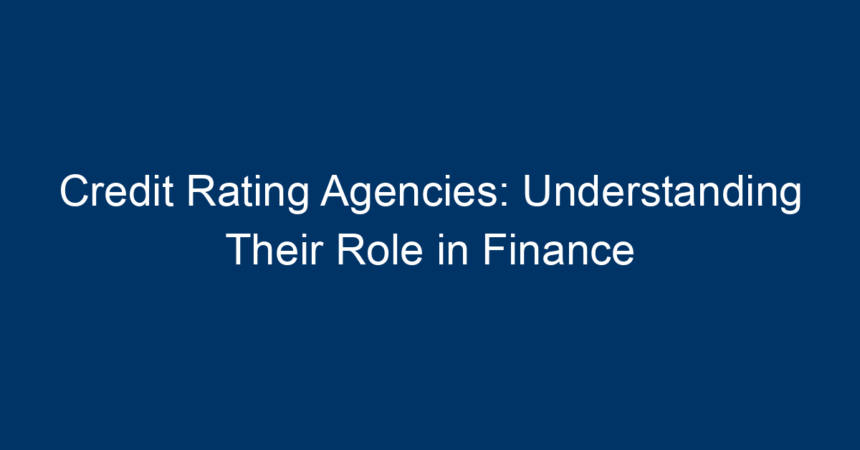In the intricate world of finance, credit rating agencies serve as pivotal entities, shaping the economic landscape. These organizations assess the creditworthiness of borrowers—ranging from governments to corporations—by evaluating their ability to repay debts. Their ratings influence everything from interest rates to investment decisions, affecting both the issuers and the broader economy. In this comprehensive article, we will explore the role of credit rating agencies, how they operate, their significance, and the challenges they face.
What Are Credit Rating Agencies?
Credit rating agencies (CRAs) are institutions that evaluate the credit risk of various entities—including corporations, municipalities, and sovereign nations. They provide a standardized method of assessing creditworthiness, assigning ratings that indicate the likelihood of default on debt obligations.
The Importance of Credit Ratings
Credit ratings are essential for several reasons:
-
Decision-Making for Investors: Investors rely on ratings to make informed decisions about where to allocate their capital. A lower rating typically translates to higher interest rates, reflecting higher risk.
-
Cost of Borrowing: Entities with high credit ratings usually enjoy lower borrowing costs since lenders perceive them as lower risk. Conversely, those rated poorly face higher interest rates, which can strain financial resources.
- Regulatory Purposes: Financial regulations often require banks and other institutions to hold a certain amount of "high-quality" assets, as defined by credit ratings. This creates additional incentive for maintaining good ratings.
The Major Players in the Credit Rating Industry
The credit rating landscape is dominated by a few large firms, often referred to as the "Big Three"—Moody’s, Standard & Poor’s (S&P), and Fitch Ratings. Each of these agencies employs its methodology for evaluating creditworthiness, but their ratings generally follow a similar scale:
- AAA: The highest rating, indicating extremely low risk.
- AA: Very low risk, but slightly more than AAA.
- A: Low risk but still vulnerable to economic changes.
- BBB: Moderate risk.
- BB and below: Increase in risk as the ratings descend to junk status.
The Rating Scale Explained
Understanding the rating scale is crucial. Here’s a breakdown:
-
Investment Grade: Ratings from AAA to BBB are considered investment-grade, suggesting a relatively low risk for investors.
- Speculative Grade: Ratings below BBB are termed speculative or high-yield, indicating increased risk and the potential for higher returns.
How Credit Ratings Are Determined
The process of determining a credit rating involves careful analysis of numerous factors. Credit rating agencies consider both qualitative and quantitative data, including:
-
Financial Statements: Agencies analyze balance sheets, income statements, and cash flow statements to gauge financial health.
-
Economic Environment: CRAs assess macroeconomic conditions, including GDP growth, inflation rates, and interest rates, affecting a borrower’s capacity to repay debts.
-
Management Quality: The experience and reputation of management play a crucial role in the evaluation process.
-
Industry Dynamics: Understanding the sector in which a borrower operates is vital. Some industries are more cyclical than others, affecting stability.
- Debt Structure: The composition and maturity of existing debt influence ratings, as agencies consider how easily borrowers can service their obligations.
The Analytical Process
The credit rating process typically comprises several stages:
-
Preliminary Assessment: Initial discussions and data gathering from the issuer.
-
In-Depth Analysis: Detailed analysis by credit analysts, incorporating both qualitative and quantitative factors.
-
Committee Review: A committee of senior analysts reviews findings and reaches a consensus on the rating.
- Final Rating: Once approved, the rating is published along with a rationale.
The Impact of Credit Rating Agencies
The influence of credit rating agencies on financial markets cannot be overstated. Here are some key impacts:
Market Movements
A change in ratings can lead to significant market reactions. For example, if a company is downgraded from investment-grade to junk status, it may trigger a sell-off among investors mandated to hold only investment-grade assets.
Regulatory Compliance
Credit ratings also affect regulatory measures. Banks and financial institutions must comply with capital adequacy norms, relying on credit ratings to determine the risk associated with various assets.
Global Financial Markets
In today’s interconnected global economy, a country’s credit rating can affect its currency value, investment attractiveness, and overall market perception—prompting international repercussions.
Challenges Faced by Credit Rating Agencies
While credit rating agencies are instrumental in assessing credit risk, they are not without their challenges.
Conflicts of Interest
One major concern is the potential conflict of interest. Credit rating agencies are typically paid by the issuers of the debt, raising questions about the objectivity of their ratings. In some cases, concerns have been raised that agencies may inflate ratings to retain business.
Over-Reliance on Ratings
Investors often depend heavily on ratings, sometimes neglecting their independent research. This over-reliance can lead to significant market distortions, as seen during the financial crisis of 2007-2008, where inaccurately high ratings contributed to the subprime mortgage disaster.
Regulatory Scrutiny
In recent years, CRAs have faced increased scrutiny and regulatory changes aimed at enhancing transparency and accountability. This can lead to a more challenging environment, potentially impacting business models.
Conclusion: Navigating the Landscape of Credit Ratings
Credit rating agencies play a crucial role in the world of finance, guiding investors and influencing economic policy. Understanding their methodologies, the implications of their ratings, and the challenges they face can empower investors and institutions alike.
Actionable Insights
-
Research Ratings: Don’t rely solely on ratings; dig deeper into the financial health and risks associated with investments.
-
Diversify Investments: Avoid over-concentration in assets solely based on credit ratings. Diversification can mitigate risk.
-
Stay Informed: Follow credit rating news and changes, as these can impact markets dramatically.
- Ethical Considerations: Be aware of potential conflicts of interest within credit rating agencies and look for independent analyses to confirm your investment strategies.
By recognizing the significance of credit rating agencies in finance, investors can make more informed decisions, enhancing their financial outcomes in a complex environment.




